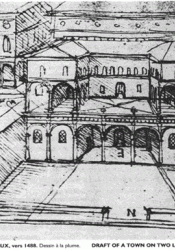Redesign of Milan
In 1485, Da Vinci outlined his idea of an “ideal city”. This was a large departure from the previous Medieval cities in Italy, where the city grew naturally and there was no set plan for the locations of waterways or streets. During the plague, almost a third of Milan’s population was killed, so Leonardo wanted to redesign Milan in a way that would reduce the spread of disease and promote efficiency of getting from one place to another. His design featured two separate levels, a lower level of canals for moving goods and common folk, and an upper level for “gentlemen”. To mitigate the chance of another widespread disease impacting the city, Da Vinci planned for the lower level to have a sewer system and the roads on the upper level to be wider than Milan’s very narrow streets so people wouldn’t be as packed together. With regard to the movement of people around the city, he envisioned large wagons and carriages using the lower level streets, making it easier for people on foot to get around on the upper level. Due to the cost of completely rebuilding Milan, Da Vinci’s ideal city was never constructed.
Sources:
“The Ideal City.” The Ideal City - Leonardo Da Vinci - Museoscienza, www.museoscienza.org/english/leonardo/models/macchina-leo.asp?id_macchin....
“Ideal City.” Leonardo Da Vinci's Ideal City Invention, www.da-vinci-inventions.com/ideal-city.aspx.
Image Source: Wikipedia Commons
https://commons.wikimedia.org/wiki/File:Projekt_idealnego_miasta.gif

